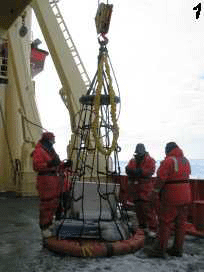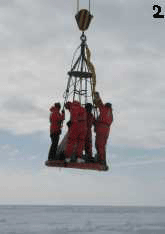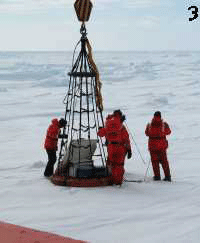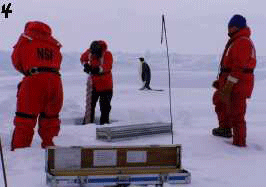|




|
|
| |
For our research on
protistan
diversity, we collect and analyze
ice samples as well a water
samples. Algae and protozoa
live in both of these types of
environments – amazing as that
may seem. The algae that live in
the ice can often be seen as
bands of brown/green color –
especially at the very bottom of
the ice. The CTD is used to
collect water from the ship, but
to collect ice, we need to get off
of the ship and use an ice corer
(called a Sipre corer). It’s an
opportunity to leave the ship
that doesn’t often occur on
expeditions in warmer climates.
There are two methods by
which we can get onto the ice –
the gangway and the personnel
basket. The gangway is lowered
when the ship is able to wedge
itself into an ice floe and remain
stable, but the personnel basket
is used at other times. The
gangway is much preferred
because people can come and
go fairly freely. On this trip to
the ice, we used the personnel
basket, which you can see in
images 1, 2 and 3. Four people
can stand along the edge of the
basket, with their equipment
stashed in the center. One of
the ship cranes is used to carry
the basket over the side and
onto the ice. Once on the ice,
we unload our equipment and
head to a sampling site (image
3). It’s necessary to move
carefully as the snow varies in
thickness and there may be
hidden pockets of melted snow
or cracks in the ice. Long metal
poles are used to “feel” through
the snow. When we reach our
selected coring site, the snow is
removed from the surface of
the ice and we assemble the
Sipre corers and begin cutting
through the ice (image 4). Our
cores on this day were between
a meter to a meter and a half in
length. An extra bonus to
working on the ice is that the
penguins usually come over to
see what we are doing – which
leads to some great photo
opportunities. The emperor
penguin you see in image 4 is
actually standing less than 5 feet
away from us – it’s not a
Photoshop enhancement.
An unofficial ‘rule’ for going
onto the ice is that you dress as
warm as possible because we
are normally out on the ice for
at least an hour in temperatures
that are well below 0C (32F).
We are issued several different
types of gloves, mittens, hats,
boots and even long underwear
to ensure that we are able to
select clothing that will keep us
warm while working outside.
The orange suits and jackets
that we are wearing in the
pictures are called mustang suits
and float coats. They are water
resistant and they float, which is
important incase we fall through
the ice or slip while working on
deck. For all of our work on
and off of the ship, we are
assisted by a Marine
Technician, who is familiar with
all of the equipment and
communicates between the
bridge and the scientists..
|

|
We will
be updating the calenders frequently with event highlights and research
progress.
|
October
|
|
Sun
|
Mon |
Tues |
Wed |
Thu |
Fri |
Sat |
| |
|
|
1 |
2 |
3 |
4 |
| 5 |
6 |
7 |
8 |
9 |
10 |
11 |
| 12 |
13 |
14 |
15 |
16 |
17 |
18 |
| 19 |
20 |
21 |
22 |
23 |
24 |
25 |
| 26 |
27 |
28 |
29 |
30 |
31 |
|
|
November
|
| Sun |
Mon |
Tues |
Wed |
Thu |
Fri |
Sat |
| |
|
|
|
|
|
|
|
|
|
|
5
|
|
7
|
8
|
|
9
|
10
|
11
|
12
|
13
|
14
|
15
|
|
16
|
17
|
18
|
19
|
20
|
21
|
22
|
|
23
|
24
|
25
|
26
|
27
|
28
|
29
|
|
30
|
|
|
|
|
|
|
|
December
|
| Sun |
Mon |
Tues |
Wed |
Thu |
Fri |
Sat |
| |
1
|
2
|
3
|
4
|
5
|
6
|
|
7
|
8
|
9
|
10
|
11
|
12
|
13
|
|
14
|
15
|
16
|
17
|
18
|
19
|
20
|
|
21
|
22
|
23
|
24
|
25
|
26
|
27
|
|
28
|
29
|
30
|
31
|
|
|
|
|